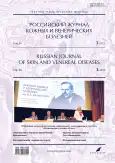Особенности клинической диагностики IgA-зависимой пузырчатки у пациентки с длительным анамнезом заболевания
- Авторы: Сорокина Е.Д.1, Криницына Ю.М.1,2, Пахомова В.В.1
-
Учреждения:
- Новосибирский областной клинический кожно-венерологический диспансер
- Федеральный исследовательский центр фундаментальной и трансляционной медицины
- Выпуск: Том 26, № 3 (2023)
- Страницы: 297-306
- Раздел: ДЕРМАТОЛОГИЯ
- URL: https://journal-vniispk.ru/1560-9588/article/view/132617
- DOI: https://doi.org/10.17816/dv321632
- ID: 132617
Цитировать
Аннотация
IgA-зависимая пузырчатка является редким аутоиммунным пузырным дерматозом и характеризуется болезненными и зудящими везикулопустулёзными высыпаниями на коже. IgA-зависимая пузырчатка представляет собой одну из самых редких форм аутоиммунных буллёзных дерматозов.
В статье описан клинический случай пациентки Т. в возрасте 82 лет, которая обратилась в Новосибирский областной клинический кожно-венерологический диспансер с жалобами на высыпания на коже туловища, конечностей, периодически сопровождающиеся ощущением зуда. Впервые высыпания начали появляться 20 лет назад, чаще в летнее время года. Наблюдалась у ревматолога с диагнозом хронического васкулита; при обострении на фоне терапии системными глюкокортикоидами высыпания регрессировали. Во время последнего обострения после перенесённой новой коронавирусной инфекции обратилась к дерматологу с частично регрессировавшими высыпаниями после инъекции раствора с бетаметазоном, что затрудняло установление диагноза. Через 2 недели на фоне отмены терапии возникло очередное обострение с явными клиническими проявлениями нейтрофильного буллёзного дерматоза в виде вялых фликтен на коже туловища, верхних конечностей, а также серозно-гнойных корок, расположенных в виде колец и гирлянд. Без использования метода иммунофлюоресценции, но на основании данных анамнеза, клинической картины и лабораторных исследований был выставлен предварительный диагноз IgA-зависимой пузырчатки, назначена терапия системными глюкокортикоидами с длительной постепенной отменой, с положительным эффектом.
Ключевые слова
Полный текст
Открыть статью на сайте журналаОб авторах
Елена Дмитриевна Сорокина
Новосибирский областной клинический кожно-венерологический диспансер
Автор, ответственный за переписку.
Email: afonnikovadoc@gmail.com
ORCID iD: 0000-0002-7965-9881
SPIN-код: 4081-2011
Россия, Новосибирск
Юлия Михайловна Криницына
Новосибирский областной клинический кожно-венерологический диспансер; Федеральный исследовательский центр фундаментальной и трансляционной медицины
Email: julia407@yandex.ru
ORCID iD: 0000-0002-9383-0745
SPIN-код: 5925-9031
д-р мед. наук, профессор
Россия, Новосибирск; НовосибирскВера Владимировна Пахомова
Новосибирский областной клинический кожно-венерологический диспансер
Email: vera9037@mail.ru
ORCID iD: 0000-0002-0379-7823
Россия, Новосибирск
Список литературы
- Kridin K., Patel P.M., Jones V.A., et al. IgA pemphigus: A systematic review // J Am Acad Dermatol. 2020. Vol. 82, N 6. P. 1386–1392. doi: 10.1016/j.jaad.2019.11.059
- Porro A.M., Caetano L.D., Maehara L.D., Enokihara M.M. Non-classical forms of pemphigus: Pemphigus herpetiformis, IgA pemphigus, paraneoplastic pemphigus and IgG/IgA pemphigus // An Bras Dermatol. 2014. Vol. 89, N 1. P. 96–106. doi: 10.1590/abd1806-4841.20142459
- Hashimoto T., Teye K., Hashimoto K., et al. Clinical and immunological study of 30 cases with both IgG and IgA anti-keratinocyte cell surface autoantibodies toward the definition of intercellular IgG/IgA dermatosis // Front Immunol. 2018. N 9. P. 994. doi: 10.3389/fimmu.2018.00994
- Kridin K. Pemphigus group: Overview, epidemiology, mortality, and comorbidities // Immunol Res. 2018. Vol. 66, N 2. P. 255–270. doi: 10.1007/s12026-018-8986-7
- Jatwani S., Holmes M.P. Subacute cutaneous lupus erythematosus [Internet] // Stat Pearls. 2021. Режим доступа: https://www.ncbi.nlm.nih.gov/books/NBK554554. Дата обращения: 20.02.2023.
- Harrell J., Harrell J., Rubio X.B., et al. Advances in the diagnosis of autoimmune bullous dermatoses // Clin Dermatol. 2019. Vol. 37, N 6. P. 692–712. doi: 10.1016/j.clindermatol.2019.09.004
- Genovese G., Venegoni L., Fanoni D., et al. Linear IgA bullous dermatosis in adults and children: A clinical and immunopathological study of 38 patients // Orphanet J Rare Dis. 2019. Vol. 14, N 1. P. 115. doi: 10.1186/s13023-019-1089-2
- Разнатовский К.И., Пирятинская В.А., Карякина Л.А., и др. Пустулезный дерматоз (болезнь Снеддона–Уилкинсона): клиническое наблюдение // Клиническая дерматология и венерология. 2017. Т. 16, N 3. С. 36–40.
- Aslanova M., Yarrarapu S.N., Zito P.M. IgA Pemphigus [Internet] // StatPearls. 2022. Режим доступа: https://www.ncbi.nlm.nih.gov/books/NBK519063/. Дата обращения: 18.02.2023.
- Bernett C.N., Fong M., Yadlapati S., Rosario-Collazo J.A. Linear IgA dermatosis [Internet] // StatPearls. 2022. Режим доступа: https://www.ncbi.nlm.nih.gov/books/NBK526113/#_NBK526113_pubdet. Дата обращения: 18.02.2023.
- Garel B., Ingen-Housz-Oro S., Afriat D., et al. Drug-induced linear immunoglobulin a bullous dermatosis: A French retrospective pharmacovigilance study of 69 cases // Br J Clin Pharmacol. 2019. Vol. 85, N 3. P. 570–579. doi: 10.1111/bcp.13827
- Toosi S., Collins J.W., Lohse C.M., et al. Clinicopathologic features of IgG/IgA pemphigus in comparison with classic (IgG) and IgA pemphigus // Int J Dermatol. 2016. Vol. 55, N 4. P. e184–e190. doi: 10.1111/ijd.13025
- Федеральные клинические рекомендации. Дерматовенерология 2015: Болезни кожи. Инфекции, передаваемые половым путем. 5-е изд., перераб. и доп. Москва: Деловой экспресс, 2016. 768 с.
Дополнительные файлы













